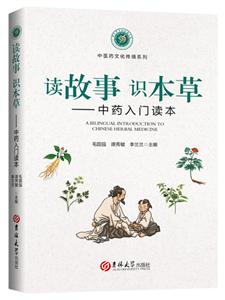-
>
(函套装)本草纲目·绣像本(全四册)
-
>
补遗雷公炮制便览 (一函2册)
-
>
方剂学
-
>
中华传统医药简明读本全4册:神奇的艾灸美颜术+神奇的中医艾灸+神奇的中医推拿+神奇的中医拔罐
-
>
常见疼痛中医简便诊治
-
>
中医经典要文便读
-
>
(精)河南古代医家经验辑
中医药文化传播系列:读故事·识本草——中药入门读本 版权信息
- ISBN:9787569249590
- 条形码:9787569249590 ; 978-7-5692-4959-0
- 装帧:一般纯质纸
- 册数:暂无
- 重量:暂无
- 所属分类:>>
中医药文化传播系列:读故事·识本草——中药入门读本 本书特色
本书不但图文并茂方便阅读,而且内容细致独特,对中医药的相关知识十分严谨。其中,许多中医大家名家用通俗易懂的话语、生动形象的表述,为读者悉心讲授节气养生的要诀。编著者十分用心,还汇集了与节气有关的民俗、谚语、古诗词等深厚的节气文化内涵,对中医药的传统文化作为一部分单独介绍,相信读者定会开卷有益,受益匪浅。
中医药文化传播系列:读故事·识本草——中药入门读本 内容简介
该书介绍了五十种常见常用的中药,以及这些中药背后的有趣故事,还介绍了药材在食品、养生、化妆品、园林绿化等方面的利用价值。书中**部分介绍了中药的相关常识,包括中药的概念、分类、食用禁忌等,第二部分介绍了50种常见中药,第三部分介绍了中药的文化。本书是双语读本,目标读者是对中药感兴趣的外国人,及来华读书的留学生。
中医药文化传播系列:读故事·识本草——中药入门读本 目录
Contents
**章中药常识
BasicknowledgeofChineseherbalmedicine
一、什么是中药?/WhatisChineseherbalmedicine 002
二、中药的分类/CategorizationofChineseherbalmedicine 004
三、中药的“四气五味”/FournaturesandfiveflavorsofChinese herbal medicine 006
四、中药的炮制/ProcessingofChineseherbalmedicine 010
五、中药的配伍/ConcertedapplicationofChineseherbalmedicine 014
六、中药的煎制/DecoctionofChineseherbalmedicine 016
七、中药的服用和禁忌/UsageandcontraindicationsofChinese herbalmedicine 020
第二章五十种常见中药介绍
Anintroductiontofiftycommon Chineseherbalmedicines
一、植物类/Botanicalmedicine 026
(一)根和根茎类/Rootandrhizome 028
人参/Renshen/Ginseng/RadixGinseng 028
大黄/Dahuang/RhubarbRootandRhizome/RadixetRhizomaRhei 033
山药/Shanyao/CommonYamRhizome/RhizomaDioscoreae 038
川乌/Chuanwu/CommonMonkshoodMotherRoot/RadixAconiti 043
丹参/Danshen/Dan - shenRoot/RadixSalviaeMiltiorrhizae 047
甘草/Gancao/LiquoriceRoot/RadixGlycyrrhizae 051
白芍/Baishao/DebarkPeonyRoot/RadixPaeoniaeAlba 055
半夏/Banxia/PinelliaTuber/RhizomaPinelliae 060
百合/Baihe/LilyBulb/BulbusLilii 065
当归/Danggui/ChineseAngelica/RadixAngelicaeSinensis 070
防风/Fangfeng/DivaricateSaposhnikoviaRoot/RadixSaposhnikoviae 075
何首乌/Heshouwu/TuberFleeceflowerRoot/RadixPolygoniMultiflori 079
贯众/Guanzhong/RhizomaDryopterisCrassirhizomae 084
桔梗/Jiegeng/PlatycodonRoot/RadixPlatycodonis 088
柴胡/Chaihu/ChineseThorowaxRoot/RadixBupleuri 092
党参/Dangshen/Tangshen/RadixCodonopsis 097
黄芩/Huangqin/BaicalSkullcapRoot/RadixScutellariae 102
黄芪/Huangqi/MilkvetchRoot/RadixAstragaliseuHedysari 106
黄连/Huanglian/RhizomeofChineseGoldthread/RhizomaCoptidis 111
葛根/Gegen/LobedKudzuvineRoot/RadixPuerariae 116
紫草/Zicao/GromwellRoot/RadixArnebiae 121
(二)全草类/Wholeherb 125
广藿香/Guanghuoxiang/CablinPatchouliHerb/HerbaPogostemonis 125
益母草/Yimucao/MotherwortHerb/HerbaLeonuri 130
麻黄/Mahuang/EphedraHerb/HerbaEphedrae 134
蒲公英/Pugongying/MongolianDandelionHerb/HerbaTaraxaci 138
薄荷/Bohe/Peppermint/HerbaMenthae 142
(三)花类/Flower 145
红花/Honghua/Safflower/FlosCarthami 145
金银花/Jinyinhua/HoneysuckleBudandFlower/FlosLonicerae 149
菊花/Juhua/ChrysanthemumFlower/FlosChrysanthemi 153
(四)果实种子类/FruitandSeed 158
大枣/Dazao/ChineseDates/FructusJujubae 158
山楂/Shanzha/HawthornFruit/FructusCrataegi 161
五味子/Wuweizi/ChineseMagnoliavineFruit/FructusSchisandrae Chinensis 165
连翘/Lianqiao/WeepingForsythiaCapsule/FructusForsythiae 169
陈皮/Chenpi/DriedTangerinePeel/PericarpiumCitriReticulatae 173
枸杞子/Gouqizi/WolfberryFruit/FructusLycii 178
砂仁/Sharen/VillousAmomumFruit/FructusAmomiVillosi 182
(五)皮类/Bark 186
杜仲/Duzhong/EucommiaBark/CortexEucommiae 186
(六)茎木类/StemandWood 190
沉香/Chenxiang/ChineseEaglewood/LignumAquilariaeResinatum190
鸡血藤/Jixueteng/SuberectSpatholobusStem/CaulisSpatholobi 195
(七)其他类/Other 199
芦荟/Luhui/Aloe 199
二、真菌类/Fungusmedicine 203
冬虫夏草/Dongchongxiacao/ChineseCaterpillarFungus/Cordyceps
Sinensis 204
灵芝/Lingzhi/GlossyGanoderma/Ganoderma 208
茯苓/Fuling/IndianBuead/Poria 213
三、动物类/Animalmedicine 217
全蝎/Quanxie/Scorpion/Scorpio 218
海马/Haima/Seahorse/Hippocampus 223
鹿茸/Lurong/VelvetAntler/CornuCerviPantotrichum 228
蜂蜜/Fengmi/Honey/Mel 234
蕲蛇/Qishe/Long - nosedPitViper/Agkistrodon 239
麝香/Shexiang/Musk/Moschus 244
四、矿物类/Mineralmedicine 248
朱砂/Zhusha/Cinnabar/Cinnabaris 248
第三章中药文化
CultureofChineseHerbalMedicine
一、古代药学家/ExpertsofChineseHerbalMedicineinAncient China 254
神农/Shennong 255
李时珍/LiShizhen 257
孙思邈/SunSimiao 260
二、中国四大药都/Four“MedicineCapitals”ofChina 263
亳州/Bozhou 263
安国/Anguo 265
樟树/Zhangshu 267
禹州/Yuzhou 268
三、诺贝尔奖与中药现代化/NobelPrizeandModernizationof ChineseHerbalMedicine 270
中医药文化传播系列:读故事·识本草——中药入门读本 节选
四、中药的炮制/ Processing of Chinese herbal medicine中药材采集后不能直接入药,要去除杂质或者非药用部位。某些具有毒性或者刺激性的药材,还需要通过炮制加以减缓。什么是中药炮制呢?简单地说,中药炮制就是根据用药需要和药物性质,对原药材进行一定的加工处理,以充分发挥中药的疗效,避免或减少一些不良反应,或改变中药原有的药性以更好地适应病情需要。具体来说,中药炮制的目的主要有四个:(一)增强中药的临床疗效中药炮制往往需要增加一些辅料,如黄酒、蜂蜜、姜汁等等。这些辅料可以增强中药的疗效,如蜜炙甘草可以增强甘草的润肺止咳作用,盐炙杜仲可以增强杜仲的补肝肾作用。(二)降低或消除药物的毒副作用,保证用药安全一些中药是有毒的,这些中药如果口服使用,就必须经过炮制来消除或降低药物的毒性。比如川乌通过炮制可以大大减少有毒成分乌头碱的含量。陈皮需要陈制至少一年来减少陈皮中挥发油的含量。(三)改变药物的性能或功效,以适应病情的需要比如地黄本身性味甘寒,适宜清热凉血,但通过黄酒反复蒸制晾晒后变为熟地黄,药性由寒变温,用于补益精血。再如麻黄善于发汗解表,而用蜂蜜炒过后的蜜炙麻黄则增强了平喘止咳的功能。(四)便于储存刚采集的鲜药材含有大量水分,容易霉变,所以中药材在储存、运输等过程中必须要通过自然晾晒或烘干进行干燥处理。有些药材需要在产地进行盐处理以防霉变,如全蝎等。中药的炮制大体包括如下方法:1.修制:对药材进行净化、粉碎或切制。属于药材的初加工,为后续进一步加工、调剂和临床用药做准备。如枇杷叶表面毛茸多,需刮去粗毛;皮类药材需要刮去粗皮;贝壳类药材需要进行粉碎;根类药材需要切片。2.水制:用水或其他液体辅料处理药材,主要是为了清洁、除杂、软化药材等目的。常见方法如漂洗、闷润、浸泡、喷洒、水飞等。3.火制:用火加工处理中药材。主要方式有炒、炙、烫、煅、煨、炮、燎、烘等。4.水火共制:主要有蒸法和煮法。如酒蒸地黄增加补肝肾和补血作用。Aftercollecting,theChinesemedicinalmaterialscannotbedirectly used.Impuritiesornon - medicinalpartsshouldberemoved.Sometoxic orirritatingmedicinesneedtobeprocessedthrough“processing”.What istheprocessingoftraditionalChinesemedicineInbrief,itmeans toprocesstheoriginalmedicinalmaterialsaccordingtotheneedsof medicationandthenatureofmedicines,soastogivefullplaytothe efficacyoftraditionalChinesemedicines,avoidorreducesomeadverse reactions,orchangetheoriginalmedicinalpropertiestobettermeetthe needsofdiseases. Specifically,therearefourmainpurposesfortheprocessingof traditionalChinesemedicine:1.EnhancingtheclinicalefficacyoftraditionalChinesemedicine Somepharmaceuticalexcipients,suchasricewine,honey,ginger juice,areoftenusedintheprocessing.Theycanenhancetheefficacy oftraditionalChinesemedicine.Forexample,honey - roastedGancao (liquoriceroot)canhavebetterlung - moisteningandcough - relieving effects.Salt - roastedDuzhong(eeucommiabark)willhavebetterliver andKidney - tonifyingeffects.2.Reducingoreliminatingtoxicandsideeffectsofherbalmedicines toensuremedicationsafety.Someherbalmedicinesaretoxic,andmustbeprocessediftheyare usedorallyinordertoreducetheirtoxicity.Forexample,aconitinein Chuanwu(commonmonkshoodmotherroot)canbegreatlyreduced afterprocessing.Chenpi(driedtangerinepeel)needstobeagedforat leastoneyearsothatvolatileoilinitcanbereducedduringaging.3.Changingtheperformanceorefficacyofherbalmedicinestomeet theneedsofdiseasesDihuang(rehmanniaroot)issweetandcoldinnature.Itissuitable forclearingheatandcoolingblood.However,itchangestoShudihuang (preparedrehmanniaroot)afterrepeatedsteaminganddryingwithrice wine.Itsmedicinalpropertieschangefromcoldtowarm,anditisoften usedtotonifytheblood.Besides,Mahuang(ephedraherb)isgoodat sweatingandreleasingexterior,whilehoney - friedMahuanghasbetter functionofrelievingasthmaandcough.4.EasystorageDuetohighmoisturecontent,thefreshlycollectedmedicinal materialsareeasytomildew.Therefore,theymustbedriedduring storageandtransportation,eitherthroughnaturaldryingorovendrying.SomemedicinalmaterialssuchasQuanxie(scorpion)needtobetreated withsaltintheproducingareatopreventmildew. Thefollowingmethodsareoftenusedinprocessingoftraditional Chinesemedicine:1.Preliminaryprocessing:Includingcleansing,crushingorcuttingof medicinalmaterials.Thepreliminaryprocessingofmedicinalmaterials preparesforfurtherprocessing,dispensingandclinicalmedication.For example,loquatleavesarehairyandthethickhairsneedtobescraped off;theroughbarksofbarkmedicinalmaterialsneedtobescrapedoff; theshellfishmedicinalmaterialsneedtobecrushed;therootmedicinal materialsneedtobesliced.2.Processedwithwater:Theprocessingofmedicinalmaterials withwaterorotherliquidexcipientsismainlyforcleaning,removing impuritiesandsofteningmedicinalmaterials.Commonmethodsinclude rinsing,moistening,soaking,spraying,grindinginwater,etc.3.Processedwithfire:SomeChinesemedicinalmaterialsare processedbyfire.Themajormethodsincludestir - frying,roasting, scalding,calcining,burning,baking,etc.4.Co - processingwithbothwaterandfire:Mainlyincludingsteaming andboiling.Forexample,steamingDihuangwithwinecanincreasethe liver - and - kidney - tonifyingandblood - tonifyingeffects.……
中医药文化传播系列:读故事·识本草——中药入门读本 作者简介
毛国强,男,1966年5月出生,天津市人。研究生学历,教授,硕士生导师。天津中医药大学文化与健康传播学院院长,兼任天津市中医药文化研究与传播中心主任、天津中医药大学健康教育与传播研究中心主任。承担本科生、硕士生传播学、中医药文化传播学等课程,主要从事大众传媒、传统文化、中医药文化传播、公众健康传播等领域研究。 谭秀敏,女,1982年12月出生,山东临沂人。毕业于南开大学外国语学院,英语语言文学硕士学位,现就职于天津中医药大学文化与健康传播学院,讲师,主要从事英语教学、中医英语翻译、中医药文化等方面的研究工作。 李兰兰,女,1979年8月出生,山东临沂人。毕业于南开大学外国语学院,英语语言文学硕士学位,现就职于天津中医药大学文化与健康传播学院,讲师。主要从事中医文化国际传播、中医名词术语英译、大学英语教学等方面的研究工作。















